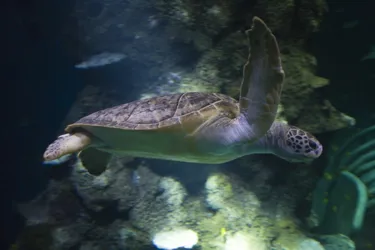The 7 Species of Sea Turtle
- Monday 5th June 2017

The Seven Species of Sea Turtles
1. Green Sea Turtle, Chelonia mydas
The Green Sea Turtle is given its name because of the green colour of fat underneath its shell. It is found in all temperate and tropical waters throughout the world, and stays near coastlines, around islands and in bays – especially in areas with lots of seagrass! This species of turtle is listed as Endangered on the IUCN Red List.
2. Loggerhead Sea Turtle, Caretta caretta
The Loggerhead Sea Turtle is given its name because of its exceptionally large head. This species prefers to feed in estuaries, coastal bays and in shallow water along the continental shelves of the Atlantic, Pacific and Indian Oceans. This species of turtle is listed as Vulnerable on the IUCN Red List.
3. Hawksbill Sea Turtle, Eretmochelys imbricata
The Hawksbill Sea Turtle is given its name because of its narrow head and hawk-like beak. It is one of the smaller species of sea turtle and is typically found tropical and subtropical waters of the Atlantic, Pacific and Indian Oceans, around coastal reefs, rocky areas, estuaries and lagoons. This species of turtle is listed as Critically Endangered on the IUCN Red List.
4. Leatherback Sea Turtle, Dermochelys coriacea
The Leatherback Sea Turtle is given its name because of its unique shell. Unlike other sea turtles, its shell is composed of a layer of thin, tough, rubbery skin which is strengthened by thousands of tiny bone plates which make it look leathery. They are primarily found in the open ocean, with a largest distribution of all sea turtles. This species of turtle is listed as Vulnerable on the IUCN Red List.
5. Kemp’s Ridley Sea Turtle, Lepidochelys kempii
The Kemp’s Ridley Sea Turtle is given its name after Richard Kemp who helped to discover and study this species of turtle. Their distribution is fairly limited, with adults found around the Gulf of Mexico and juveniles along the east coast of the US and the Northwest Atlantic Ocean. This species of turtle is listed as Critically Endangered on the IUCN Red List.
6. Olive Ridley Sea Turtle, Lepidochelys olivacea
The Olive Ridley Sea Turtle is given its name because of its olive green coloured shell. It inhabits tropical and subtropical waters of the Pacific, Indian and Atlantic Oceans, found in coastal bays and estuaries. This species of turtle is listed as Vulnerable on the IUCN Red List.
7. Flatback Sea Turtle, Natator depressus
The Flatback Sea Turtle is given its name because its shell is incredibly flat. It has a very limited distribution, found only in the waters around Australia and Papua New Guinea along coastal coral reefs and grassy shallows. This species of turtle is listed as Data Deficient on the IUCN Red List.
So what are the threats?
Sea Turtles face a number of threats in the wild, affecting species all over the world and placing many of them under endangered or critically endangered criteria on the IUCN Red List. Coastal development around nesting beaches presents a threat to newly hatched juveniles and expansion of coastal towns and cities reduces beach size. Plastic pollution is a global problem that affects not just turtles but a large number of marine species. Turtle often mistake plastic bags and other items for food, consuming pieces of plastic floating in the oceans. Additionally, destructive fishing practices are harming both turtles and their habitats, as trawler nets scrape along the ocean floor and large nets catch turtles accidentally. All of these issues, and many others, are resulting in a declining number of sea turtles worldwide.
What can you do to help?
To help protect sea turtles worldwide you can join Team Turtle and be part of the SEA LIFE Trust’s brand new campaign encouraging you to reduce your use of plastic and eat more sustainable seafood. Challenge yourself to use a reusable water bottle, stop asking for straws in drinks and use a bag for life in order to prevent the plastic pollution problem from escalating even more.